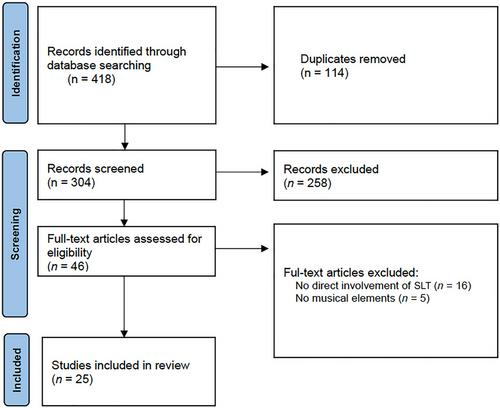A growing body of research indicates that music-based interventions show promising results for adults with a wide range of speech, language and communication disorders.
The purpose of this scoping review is to summarize the evidence on how speech-language therapists (SLTs) use music and music-related elements in therapeutic interventions for adults with acquired neurogenic communication impairments.
This scoping review was completed using the Preferred Reporting Items for Systematic Reviews and Meta-Analyses Extension for Scoping Reviews guidelines. A systematic search of three databases (Allied and Complementary Medicine Database, Cumulative Index to Nursing and Allied Health Literature and OVID Medline) was conducted and articles were included if they (1) incorporated adult human participants; (2) received an assessment or intervention facilitated by an SLT; (3) incorporated techniques and interventions which included music-related elements (e.g., rhythm, melody, harmony and dynamics); (4) were written in the English language; and (5) were peer-reviewed full-text articles. Data were extracted using the Rehabilitation Treatment Specification System framework.
A total of 25 studies met the inclusion criteria. The studies included participants with neurogenic communication impairments secondary to stroke, Parkinson's disease, dementia and traumatic brain injury. Musical interventions identified in the studies were Melodic Intonation Therapy, Modified Melodic Intonation Therapy, choral singing, singing therapy and songwriting. The majority of the studies reported interprofessional collaboration between SLTs and at least one other healthcare clinician and/or musician. Many studies also included music-based interventions lead and facilitated by musically trained SLTs.
The results of the studies included in this review indicate that SLTs are using music-based interventions to target therapeutic goals to improve speech, language, voice and quality of life in collaboration with other clinicians and professional musicians.
A growing body of research indicates that interventions using music (i.e., choirs and songwriting) and musical elements (i.e., rhythm and dynamics) show promising results for adults with neurogenic communication impairments. Currently, however, there is no clear indication of how speech-language therapists (SLTs) are using music in their clinical practice.
This scoping review collates the current evidence on how SLTs use music and musical elements in their clinical practice. SLTs are using music and musical elements for individuals with neurogenic communication impairments in populations such as Parkinson's disease, dementia and traumatic brain injury. Common interventions described in the literature include Melodic Intonation Therapy, choral singing, singing therapy and songwriting.
Many SLTs collaborate when delivering music-based interventions, particularly with music therapists (MTs). This scoping review suggests that SLTs should continue to explore music-based interventions in collaboration with MTs and professional musicians to target therapeutic goals to improve speech, language, voice and quality of life.



